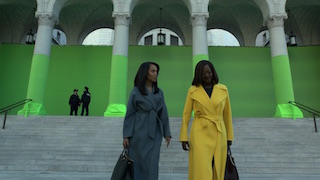 VFX Legion recently created the visual effects for the highly anticipated crossover episodes of Scandal and How to Get Away with Murder. Legion has handled all of the visual effects for both shows for almost three-years. However, the crossover episodes required visual effects that blended with two series that use different tools and each have their own look, presenting a more complex set of challenges.
VFX Legion recently created the visual effects for the highly anticipated crossover episodes of Scandal and How to Get Away with Murder. Legion has handled all of the visual effects for both shows for almost three-years. However, the crossover episodes required visual effects that blended with two series that use different tools and each have their own look, presenting a more complex set of challenges.
For one, Scandal is shot on an Arri Alexa camera, and How to Get Away with Murder on a Sony F55, at different color temps, and under varying lighting conditions. DP preferences and available equipment required VFX Legion to shoot the same environments twice, once with green screens for Scandal and then again using blue screens for How to Get Away with Murder. Its team addressed all of these variables, finding creative solutions to bridge the look and match the texture and tone of both series.
The Los Angeles-based company created a mix of photorealistic CG environments and other effects that made it possible to transport the actors into a variety of digital surroundings that seamlessly match the live-action footage, and defy the viewer’s eye. The invisible effects dramatically augment the shows’ visual landscapes with shots that would be either too expensive or impossible to shoot on location.
The replication of the Supreme Court Building is central to the storyline. Building its exterior facade, and interiors of the courtroom and rotunda digitally, from the ground up, were the most complex visual effects shows created for the episodes.
The process began during pre-production with VFX supervisor Matthew T. Lynn working closely with the client to get a full understanding of their vision. He collaborated with Legion’s head of production, Nate Smalley, production manager, Andrew Turner, and coordinators Matt Noren and Lexi Sloan, on streamlining workflow and crafting a plan that aligned with the shows’ budgets, schedules, and resources. Lynn spent several weeks on research and development, pre-visualization, and mockups. Legion's end-to-end approach was presented to the staffs of both shows during combined VFX meetings, and a plan was finalized.
 A rough 3D model of the set was contructed from hundreds of reference photographs stitched together using Agisoft Photoscan, and a technique called photogrammetry. HDRI panoramas and 360° multiple exposure photographs of the set were used to match the 3D lighting with the live-action footage. CG modeling and texturing artist, Trevor Harder, then added the fine details and created the finished 3D model.
A rough 3D model of the set was contructed from hundreds of reference photographs stitched together using Agisoft Photoscan, and a technique called photogrammetry. HDRI panoramas and 360° multiple exposure photographs of the set were used to match the 3D lighting with the live-action footage. CG modeling and texturing artist, Trevor Harder, then added the fine details and created the finished 3D model.
CG supervisor, Rommél S. Calderon, headed up the team of modeling, texturing, tracking, layout, and lighting artists that created D.C.'s Supreme Court Building from scratch.
“The CG model of the exterior of the building was a beast and scheduling was a huge job in itself,” says Calderon. “Meticulous planning, resource management, constant communication with clients and spot-on supervision were crucial to combining the large volume of shots without causing a bottleneck in VFX Legion’s digital pipeline.”
Ken Bishop, VFX Legion’s lead modeler, ran into some interesting issues while working with footage of the lead characters, Pope and Keating filmed on the concrete steps of LA’s City Hall. Since the Supreme Court’s staircase is marble, Bishop did a considerable amount of work on the texture, keeping the marble porous enough to blend with the concrete in this key shot.
Tracker, Ruy Delgado achieved a perfect lock on the camera moves in SynthEyes using photogrammetry, lens specs, camera measurements and other on-set survey data. The depth of detail enabled him to match the marble columns inside the courthouse exactly.
Working from overcast and flatly lit plates, lighting artist Bryan Shepperd added interest to the feel of the shots, while maintaining the continuity needed to blend with the shows.
Compositing supervisor, Dan Short, lead his team through the process of merging the practical photography with renders created with Redshift and then seamlessly composited all of the shots using The Foundry’s Nuke.
“These episodes required a combination of good planning and a talented team of over 25 artists and support staff,” said Lynn. “We pulled out all the stops to deliver a large shot counts of complex, high-quality VFX, and make last minute changes, while still meeting a tight deadline and getting the most value out of the budget.”
“The crossover episodes of Scandal and How to Get Away with Murder showcase some of the best television visual effects that VFX Legion has created to date,” added James David Hattin, the company’s founder, creative director, and senior VFX supervisor. “I’m very proud of all of the hard work that our team put into these shows and the results we achieved. Watching the final shows on air was jaw-dropping.”
The storylines of the political thriller and legal drama intersect in the back-to-back two-hour event that premiered this month on ABC and continues to rank as a streaming favorite on Hulu.
VFX Legion www.vfxlegion.com
